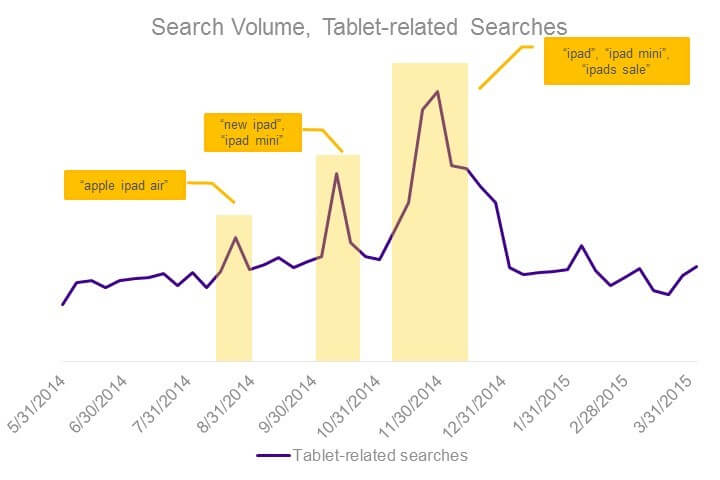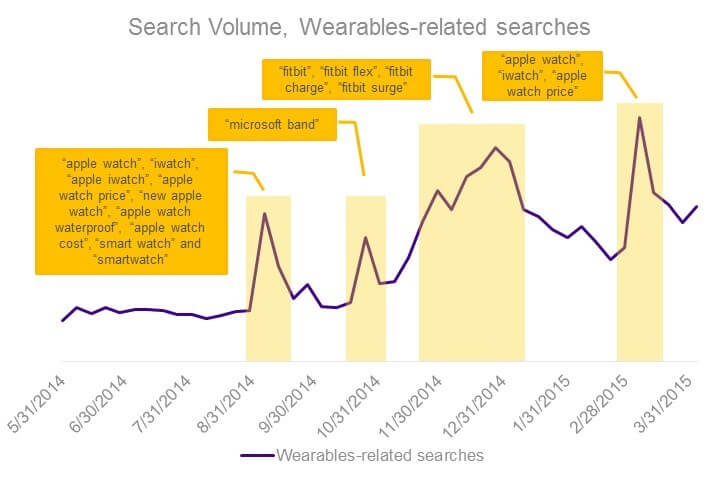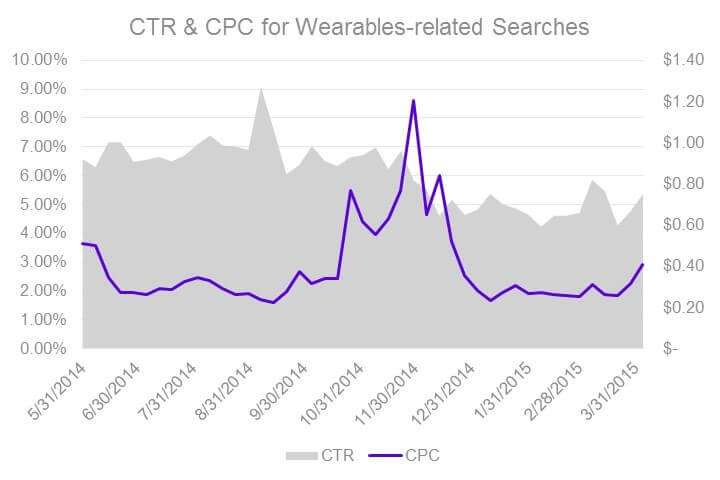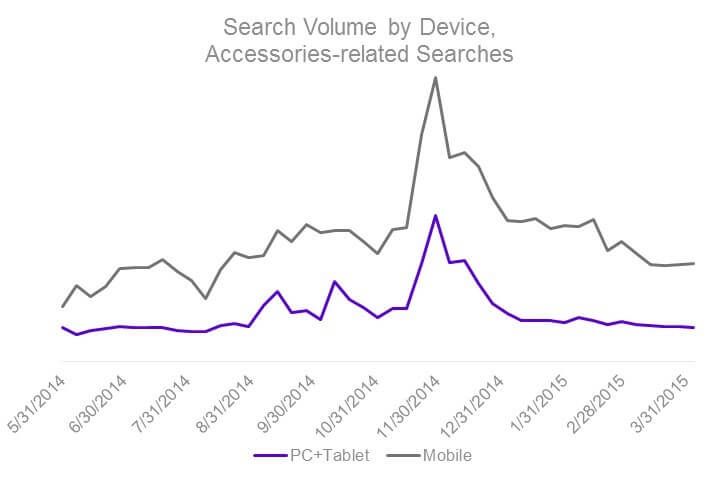New Device Launch Campaigns: Key Insights For Online Advertising Success
About to launch your first device-specific paid search campaign for smartphone, tablet, wearable, or something else entirely? If so, columnist John Cosley of Bing has some tips!
No matter what our age, we all love a new toy — especially when it features the latest technology. And if you happen to be one of the lucky advertisers on the cusp of launching a new device, like a smartphone, tablet, accessory, or (the new favorite) wearables, you’re also on the verge of a huge opportunity — provided, of course, you know how to capitalize on it.
According to a recent eMarketer report, “The US Telecom and Computing Products and Consumer Electronics Industries 2015: Digital Ad Spending Forecast and Trends,” U.S. digital ad spending related to new devices is expected to reach $10.9 billion in 2015, including $6.5 billion on telecom-related ads. So it only makes sense to look at past campaign data and put that information to good use. Here are some actionable insights collected from Bing Network’s data to set your new device launch campaign on the path to success.
For Any New Device: Make Your Campaign Mobile-Friendly & Optimized
Mobile search volume on the Bing Network across “New Device”-related categories is on par with search volume from PCs and tablets. In fact, mobile searches accounted for 49% of all smartphone-related searches, 48% of all tablet-related searches, and 41% of wearable-related searches.
For accessories, mobile search volume is more than double that of PC and tablet search — 70% vs. 30%. It’s critical for new device campaigns to be optimized for mobile and for landing pages to be mobile-ready. Advertisers can use mobile Bid Modifiers to grab top positions and reach this growing audience.
Smartphones
You may think that everyone you know has a smartphone, and for the most part, you’re right: According to eMarketer’s “US Digital Users: Q1 2015 Complete Forecast” (available to customers only), 59% of Americans, including 68% of adults, have smartphones. eMarketer predicts that the number of smartphone users will increase by 11% this year as more people choose phablets over tablets and more seniors change to smartphones from feature phones.
Smartphone-related searches align with product announcements. If Apple is announcing a new product, you can expect searches for smartphones to peak during that week, with queries related to the new products driving this surge. For example, around Apple’s September 2014 announcement, the top search queries included: “iPhone 6,” “iPhone 6 release date,” “iPhone,” and “Apple iPhone 6.” This peak also aligned to a spike in both click-through rate and cost-per-click. Savvy advertisers should monitor the news for upcoming product announcements and prepare for increased traffic and competition, planning their campaigns, budgets and keywords to align with these events.
Take advantage of the secondary market. In addition to this peak, there’s typically a rise in searches for older models after a new model is released. This secondary market — consumers who are looking to sell their current phones, upgrade to a new model, or buy discounted older models — also makes the time following these announcements a great time for smartphone advertisers to plan campaigns.
Smartphones are searching for smartphones. As more people search on the go, it’s no surprise that both external research and Bing’s internal analysis show that consumers shopping for and researching new smartphones often do so on their smartphones. On the Bing Network, 49% of smartphone-related searches came from smartphones over an 11-month period ending in April. To reach this on-the-go audience, advertisers with physical storefronts can use location extensions and location targeting, in addition to mobile bid modifiers.[1]
Tablets
While the adoption of smartphones is on the rise, tablet adoption is slowing down as it approaches 65% of Internet users.[2]
Prepare your campaigns for Black Friday and holiday traffic. While new product announcements result in search spikes, tablet-related searches increase steadily in the weeks leading up to Black Friday and stay high throughout the holiday season.
Advertisers need to prepare and optimize their campaigns to take advantage of this seasonal surge. One way to do that is to use Automated Rules for keyword bidding and budget adjustments to help your campaigns stay competitive during this critical period.
Wearables
With all the buzz around the release of the new Apple Watch this spring, and competitors popping up everywhere, eMarketer expects the Wearables category (including smartwatches/wristbands, glasses and jewelry) to grow from $3.3 billion this year to $18 billion by 2020.
According to a survey by Ipsos Connect, one in five American adults intends to buy a wearable in 2015, with 19% of those ready to buy a wearable fitness monitor and 13% ready to buy a wearable computer.
Plan for both the holidays and product news. Wearables-related searches on the Bing Network have grown this year and remain high as consumer interest grows and new wearable products are announced and released. In addition to announcement spikes, there was a longer peak around the holidays for wearable fitness monitors, led by searches for Fitbit products. If you are a wearable-related advertiser, plan seasonal campaigns to grab holiday shoppers and New Year’s resolution makers. You should also monitor the news for upcoming product announcements and releases and plan campaigns for those events.
Enjoy high CTRs and low CPCs. Because this is an emerging category, advertisers can enjoy low costs-per-click and high click-through rates. On the Bing Network, CPC stayed below $0.60 most of the year, while CTR was above 4%.
Accessories
Mobile-first is the way to go. Mobile is where it’s at for accessories-related searches, with smartphone search volume more than double the PC and tablet search volume on the Bing Network. It’s critical for advertisers in this category to have mobile-optimized campaigns. They also need to use Mobile Bid Modifiers to get the most exposure.
Plan for the holidays. In terms of timing, accessories-related searches peak around Black Friday and the holidays as smartphone owners and gift-givers look to cover, equip and power smartphones, tablets and other devices. To make the most of the holiday peak, advertisers should allocate the bulk of their budget to this time and monitor the popularity of devices and their accessories to see what’s on people’s wish lists.
Advertiser Takeaway
Launching a new device can be daunting — but your online campaigns don’t have to be. Make sure you plan around other big product launches, know how and where your consumers are searching, plan for the holidays — and, of course, optimize your campaigns for the ever-growing number of on-the-go searchers. By following these simple guidelines, your new device can stand out from the competition, and you can help your customers find — and love — their newest toy.
[1] Microsoft internal analytics – Yahoo! Bing Network, Owned & Operated, weekly data 5/31/2014–4/10/2015
[2] eMarketer, US Digital Users: Q1 2015 Complete Forecast, February 2015
Opinions expressed in this article are those of the guest author and not necessarily Search Engine Land. Staff authors are listed here.
Related stories





